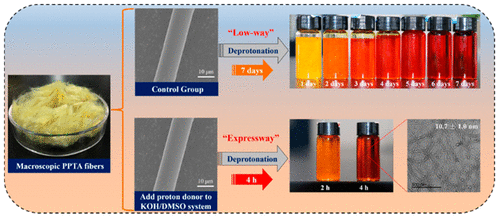Our official English website, www.x-mol.net, welcomes your
feedback! (Note: you will need to create a separate account there.)
Timesaving, High-Efficiency Approaches To Fabricate Aramid Nanofibers
ACS Nano ( IF 15.8 ) Pub Date : 2019-06-18 00:00:00 , DOI: 10.1021/acsnano.9b02258
Bin Yang 1 , Lin Wang 1 , Meiyun Zhang 1 , Jingjing Luo 1 , Xueyao Ding 1
ACS Nano ( IF 15.8 ) Pub Date : 2019-06-18 00:00:00 , DOI: 10.1021/acsnano.9b02258
Bin Yang 1 , Lin Wang 1 , Meiyun Zhang 1 , Jingjing Luo 1 , Xueyao Ding 1
Affiliation

|
Aramid nanofibers (ANFs) have become promising nanoscale building blocks due to their extraordinary performance. However, there are numerous challenges related to the preparation of ANFs, such as the lengthy preparation cycle (7–10 days), low preparation concentration (0.2 wt %), and high difficulty in quantitatively judging the end point of the deprotonation reaction. Herein, we report three time-saving and high-efficiency strategies (fibrillation, ultrasonication, and proton donor-assisted deprotonation) to prepare ANFs with excellent performance. The fiber micromorphology during the deprotonation and protonation recovery processes was first investigated. Then the end point of the deprotonation reaction was detected by Raman spectra and the cationic demand of the ANF/DMSO system. Finally, the size, preparation cycle, and performance of the corresponding ANFs and ANF films fabricated by different approaches were investigated in detail. The results showed that proton donor-assisted deprotonation significantly shortened the traditional preparation cycle from 7 days to 4 h, and is the most efficient method reported thus far. It is noteworthy that a high concentration of ANFs (4.0 wt %) could also be achieved within 12 h. Interestingly, the fabricated ANFs exhibit rigid morphology and a small diameter with a narrow size distribution (10.7 ± 1.0 nm). The resultant ANF film displays desired characteristics of high strength and toughness. The work offers a timesaving, feasible and effective strategy to realize the large-scale production for ANFs, which will facilitate the application of ANFs in the production of advanced nanomaterials.
中文翻译:

省时,高效的芳族聚酰胺纳米纤维制造方法
芳族聚酰胺纳米纤维(ANFs)由于其非凡的性能而成为有前途的纳米级构建基块。但是,与ANF的制备相关的挑战很多,例如制备周期长(7-10天),制备浓度低(0.2 wt%)以及定量判断去质子化反应终点的难度大。在此,我们报告了三种省时,高效的策略(原纤化,超声处理和质子供体辅助的去质子化),以制备性能优异的ANF。首先研究了去质子化和质子化恢复过程中的纤维微观形态。然后通过拉曼光谱和ANF / DMSO体系的阳离子需求量来检测去质子化反应的终点。最后,尺寸,准备周期,并详细研究了用不同方法制备的相应ANF和ANF膜的性能。结果表明,质子供体辅助的去质子化将传统的制备周期从7天显着缩短到4 h,是迄今为止报道的最有效的方法。值得注意的是,在12小时内也可以达到高浓度的ANF(4.0 wt%)。有趣的是,所制造的ANF呈现出刚性的形态和较小的直径,且具有窄的尺寸分布(10.7±1.0 nm)。所得的ANF膜显示出所需的高强度和韧性的特性。该工作为实现ANFs的大规模生产提供了一种省时,可行,有效的策略,这将有助于ANFs在先进纳米材料生产中的应用。
更新日期:2019-06-18
中文翻译:

省时,高效的芳族聚酰胺纳米纤维制造方法
芳族聚酰胺纳米纤维(ANFs)由于其非凡的性能而成为有前途的纳米级构建基块。但是,与ANF的制备相关的挑战很多,例如制备周期长(7-10天),制备浓度低(0.2 wt%)以及定量判断去质子化反应终点的难度大。在此,我们报告了三种省时,高效的策略(原纤化,超声处理和质子供体辅助的去质子化),以制备性能优异的ANF。首先研究了去质子化和质子化恢复过程中的纤维微观形态。然后通过拉曼光谱和ANF / DMSO体系的阳离子需求量来检测去质子化反应的终点。最后,尺寸,准备周期,并详细研究了用不同方法制备的相应ANF和ANF膜的性能。结果表明,质子供体辅助的去质子化将传统的制备周期从7天显着缩短到4 h,是迄今为止报道的最有效的方法。值得注意的是,在12小时内也可以达到高浓度的ANF(4.0 wt%)。有趣的是,所制造的ANF呈现出刚性的形态和较小的直径,且具有窄的尺寸分布(10.7±1.0 nm)。所得的ANF膜显示出所需的高强度和韧性的特性。该工作为实现ANFs的大规模生产提供了一种省时,可行,有效的策略,这将有助于ANFs在先进纳米材料生产中的应用。































 京公网安备 11010802027423号
京公网安备 11010802027423号